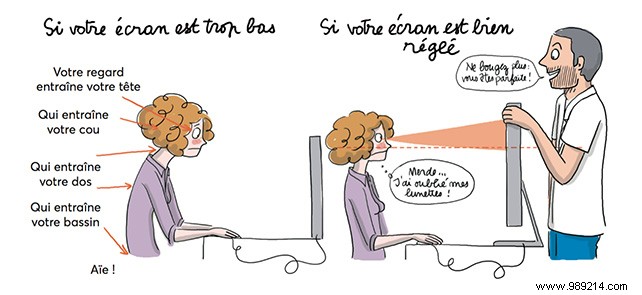 To relieve muscle tension located in the back and neck, nothing like a few stretching exercises. trapezius, those muscles that run from the spine to the shoulders.
To relieve muscle tension located in the back and neck, nothing like a few stretching exercises. trapezius, those muscles that run from the spine to the shoulders. Poor posture at work, long hours sitting in front of the computer, uncomfortable positions adopted on the train, on the sofa and even in bed, a peak of stress... There are many reasons that create tension in our trapezius, these muscles located in the back and neck, sometimes causing significant back pain.
To soothe these tensions and relax this area which extends from the spine to the shoulders, we asked for the advice of professionals:Lucile Woodward, sports coach and Frédéric Srour, physiotherapist and ergonomist, author of Même pas mal ! The guide to good gestures and good postures . Between good habits to adopt on a daily basis, easy exercises and stretching, here are their techniques to relax the trapezius muscles and relieve stiff backs.
Before all other things, you should know that there are two kinds of trapezoids. The upper traps - they are often the ones that are the most painful - are the muscles between the shoulders and the neck. The lower trapezius muscles are usually responsible for shoulder pain when they are overstretched. These muscles, which ensure a good support of the bust, are with the psoas, the calves and the glutes an important zone of concentration of the stress. We therefore try to make them work through small exercises of rotation of the shoulders.
Video of the day:On a daily basis, to soothe muscle tension, Lucile Woodward advises practicing self-massage. For example, to massage the left trapezius, we hold the left elbow with our right hand, to support it. With our left hand we grab our trapeze and massage it. The sports coach recommends applying, at the same time, arnica oil, which is very effective in relieving muscle tension. Ideally, repeat this easy massage twice a day, massaging for 3-4 minutes each time.
The other technique on which the two experts agree consists of an ultra-easy exercise, which has the benefit of releasing pressure in the upper back.
To do this, we inhale and raise our shoulders very high. We block 3 to 4 seconds at the top, then we release suddenly while blowing. This exercise, to be repeated several times in a row if necessary, gets the blood flowing, relaxes the trapezius muscles and works on our breathing, which is so precious.
 © Not bad at all! - illustrations Emmanuelle Teyras
© Not bad at all! - illustrations Emmanuelle Teyras
In case of pain in the trapezius area, Lucile Woodward also recommends a stretching exercise to reduce muscle stiffness.
In practice, we must stick our right ear to our right shoulder, very gently. Then, we bring our chin to the chest. This movement stretches and relaxes the trapezius muscles. It is recommended to perform it in one direction, then in the other, taking our time so as not to do us more harm than good.
To relieve knotted trapezius, Frédéric Srour has a secret, easy to apply anytime and anywhere, in the car, in the queue at the supermarket, in front of his computer, while cooking...
This consists of small rotations of the shoulders back and forth. By doing 3 sets of 10 rotations each day, the trapezius gradually relaxes and tensions disappear. In front of the computer, at the office or at home, you can also move your head and shoulders quite well by practicing small movements from left to right and from bottom to top is recommended. Another important tip:we must vary the sitting positions and allow ourselves to move around to relax a little.
In addition to its anti-stress benefits, yoga has, among other things, the virtue of relaxing the muscles. For the trapezes, Lucile Woodward recommends the posture of the eagle (Garudasana). It is a balancing posture that is practiced standing and which requires a little concentration as can be seen in the video below. It is nevertheless accessible to beginners as well as to experienced yogis.
First cause of trapezius tension, screens. These turn out to be our worst enemies when we are prone to muscle pain.
To relieve trapezius and other back pain, professionals agree that it is imperative to reduce our time in front of a screen as much as possible. To do this, we are a good student and we impose digital detox during which we cut computers and smartphones. As important as they are, they promote lowered heads and often muscle contractures.
In the office, if you have to read printed documents, it is better to place them between the keyboard and the screen and not on the side. Also, let's take the time to read them while leaning against the seat, rather than leaning over our workstation. Our body will thank us.
Last advice delivered by Frédéric Srour and particularly addressed to those who spend long hours in a seated position:organize your workstation and adjust your screen(s) to avoid pain.
Thus, facing a computer, it is advisable to adopt a posture as straight as possible (do not hesitate to adjust the height of your chair, the angle of your backrest and the armrests) and to place your gaze almost at the horizontal of the screen, the eyes facing the upper third of the latter. In this way, our neck does not pull the rest of our body forward, creating an imbalance that inevitably forces the trapezius muscles.
 © Not bad at all! - illustrations Emmanuelle Teyras
© Not bad at all! - illustrations Emmanuelle Teyras